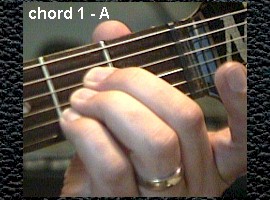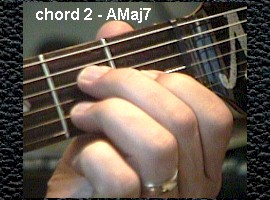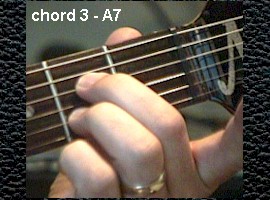Scroll through the lesson and click on notation/video/audio links to load the interactive players.
| Lyle Ronglien >> Rock Legends >> |
|
|
Please subscribe to get full access to all lessons for only $7.95/month PLUS 1 week free trial.

Riff Interactive lessons are
LESS expensive and
MORE interactive than alternatives!
More Info
|
|

ROCK LEGENDS I - GEORGE HARRISON
Lyle: George Harrison (1943 - 2001)
was the lead guitarist for the world's most famous group, the Beatles. A.K.A.
the quiet Beatle, he was the one who introduced Indian Mysticism, the sitar, and
the Maharishi to the rest of the Beatles. George's early influences were
guitarists Chet Atkins, Carl Perkins and Duane Eddy. In his early professional
years he played Gretsch guitars like the models Duo Jet, Country Classic,
Tennessee Rose. He also favored the Rickenbacker 12 string electric guitar. The
amps he used in the early days were made by Vox then soon he switched to using
mostly Fender amps. George was also a part of the super
group, The Traveling Wilburys, which featured Tom Petty, Jeff Lynne, Bob Dylan,
Roy Orbison and himself.
Lyle: Besides playing some of the world's most
recognizable rock riffs and introducing the sitar to modern pop music, George
loved to play slide guitar. His slide guitar style was very melodic instead of a
traditional blues based style. Suggested listening: Something,
Here Comes The Sun, While My Guitar Gently Weeps,
Taxman, My Sweet Lord.
Lyle: Take a listen to the Lesson Sample that
I wrote and recorded for this lesson. The first half features an Indian
influenced sitar solo; the 2nd half of the sample features a slide guitar solo
in the style of George. You will be learning how to play all the parts of this
Sample during this lesson.
Lesson Sample
tom: George
was a real classy guy.
Lyle: He sure was.
To create a sitar like sound, it helps to use an exotic scale like the harmonic
minor:
Lyle:
The harmonic minor scale is like a natural minor (1 - 2 - b3 - 4 - 5 -
b6 - b7) scale but with a b3 and b6 only (1 - 2 - b3
- 4 - 5 - b6 - 7). Try playing the scale over this jam
track:
Looping
Sound Clip 1
Lyle: Another way to create a sitar like sound
on your guitar is with the use of a heavy vibrato.
Lyle:
Check out this riff from the intro of the Lesson Sample, you'll hear a quick and
heavy vibrato:
tom: That
Harmonic minor does sound very Indian.
Lyle: Here's a video of me playing this riff.
I'm using a midi guitar hooked to a synth with a setting that sounds just like a
sitar. Notice the quick and heavy
vibrato:
sitar solo
guitarman:
Yeah, that sounds good with the jam
track!
Lyle: Play around with the riff and the scale.
Also try droning the open A (5th) string as you mess
around.

Lyle: The next part of this lesson points to
the 2nd half of the lesson sample, where the slide guitar
is. Here's the jam track you'll be using for
this part:
Looping
Sound Clip 2
Lyle: It's made up of 4 chords, 1 for each
measure. Here's pictures of them, followed by the TAB with
fingerings:




Lyle:
The jam track, or background music is layered with several instruments. Each one
is unique to the overall sound. George was a big fan of the 12 string
electric guitar, so I made a rhythm 12 string part that goes like
this:
Lyle:
Notice each chord is strummed on the first beat (down beat) of each measure, then arpeggiated. The piano has an interesting
part you can play on the guitar. The chords are the same but you'll play
them way up the neck in a different voicing like this:
piano part
Lyle: Again I cheated, I used my midi guitar
hooked into a synth to get the piano sound, but you can still learn the part on
guitar for good practice.
Lyle: Can you see and hear the difference between the
12 string guitar part and the piano part? They can work together in one groove
without overpowering each other. An organ part is also used. To emulate
an organ on your guitar, try a clean sound, neck pickup, maybe a little chorus
effect added.
tom: So by just
adding a Ab to the A chord it becomes a Maj7 ?
Lyle: Yes Tom. Ab is the 7th degree in the A major
scale.
tom: And
so it's called a Maj 7?
Lyle:
Yes. Basic chords (called triads)
are made from the 1 - 3 - 5 tones of the scale. Add the 7th and you get the major 7
chord (1 - 3 - 5 - 7).
Lyle: Next is another sitar part, this time
without the heavy and fast vibrato, just playing the chords and arpeggiating
them:
Lyle:
There are two more parts that make up the jam track, then we'll get to the solo
slide guitar. First is a slide guitar playing a
repeated melody. This should remind you of George's style a
bit:
slide guitar part
1
Lyle: Next I'd like to show you the harmony
guitar part for the slide riff you just learned:
slide guitar part
2
Lyle: Next you'll learn the slide
guitar solo from the Lesson Sample. George played a melodic style of slide
guitar instead of the bluesy sounding
licks. This solo is made from a repeating
melody that climbs the neck. Here's the main melody:
solo - riff 1
Lyle: Next the solo repeats the melody just an
octave higher:
solo - riff
2
Lyle: Part 3 of the solo I went away from the
theme/melody and played something close to a blues riff but again, more
melodic:
solo - riff 3
Lyle: The 4th and final riff of the solo
brings you back to the main melody, this time as high up the neck you can
reach:
solo - riff 4
Lyle: George was very good at many styles of
music. That's why he was the lead guitarist in the world's most famous
band. As a legend, he's right up there with
Hendrix.
Lyle:
That's all for this lesson. See you at the next lesson! If you would like to
study more of this or any other style, email me at
Lyle@theguitar.net for more info. - Lyle

|
<< load notation from left
|
|
<< load audio from left
|
<< load audio from left
|